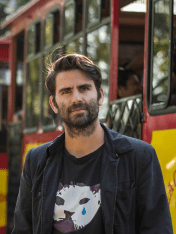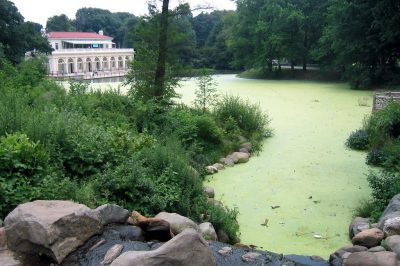Still from 'Sons of Monarchs'
Butterfly effect: ‘Sons of Monarchs’ and the human connection to the natural world
Alexis Gambis’ new film will be streaming on HBO Max starting November 2—which is not coincidentally the Dead of the Dead
Brooklyn-based filmmaker Alexis Gambis wants to break the stereotypes of how we think about scientists in movies, which can veer from cold and analytical to flat out mad. But rarely are they three-dimensional humans. For Gambis, the goal is to make scientists more relatable, fragile and vulnerable—and less like Dr. Frankenstein.
Gambis’ new film “Sons of Monarchs” explores human connection to the natural world through the character Mendel, played by actor Tenoch Huertahe. In “Monarchs,” Mendel emigrates from the West Mexican state of Michoacán to New York City, where he (gruesomely at times) dissects the monarch butterflies that migrate from the forests of his home Michoacán to the U.S., onto Canada, and back, beginning November 2 every year.
“On the Day of the Dead, in Mexico, the butterflies arrive—and they are the soul of our relatives,” the narrator says in the film’s trailer.
As such, “Sons of Monarchs” revisits the idea of territories at various scales, from the vein of a butterfly wing to the border between countries. By using the butterfly as a representation of border crossing, and by placing its immigrant protagonist in a contemporary urban setting, the film questions the notion that “good fences make good neighbors,” as Robert Frost put it.
Mendel’s connection to the monarch stems from a painful loss early in life. Pivotal moments in the story happen during Day of the Dead, which coincide with the monarch’s journey, and the two come to mean something about the cyclical nature of love and loss that you have to see to believe.
Brooklyn Magazine spoke with Gambis, who is himself French-Venezuelan, about making scientists humane on screen by grounding them in real-world problems, how he turns real science into magical cinematic moments, and whether it’s possible to use the pigmentation from a butterfly to color a tattoo. The film will itself be available for streaming beginning November 2 on HBO Max.
This interview has been lightly edited for clarity and concision.


Gambis: Father of ‘Sons’
The crux of “Sons of Monarchs” is about tradition and family, but with science. Is this a personal story for you?
It took me a while to figure out that it was actually a personal story. I didn’t consciously think about it when I was writing it, but it definitely is my story. I was a scientist. I technically still am a scientist—I did a PhD in molecular biology—and I was a scientist in my mid 20s working in a laboratory in New York and struggling with sudden family loss and trying to find who I was. At the same time, I was spending my day looking through a microscope at insects, I wasn’t working with butterflies, I was working with fruit flies. I was actually working on the genetics of vision and how we see color.
How did you, unconsciously or not, place your experience in the story?
“Son of Monarchs” is a character portrait of Mendel, somebody that studies life, but at the same time is trying to understand their own identity. I think we don’t often realize how much science and spirituality are very much tied together. I feel like sometimes we separate them, we say that they’re confounding worlds but there’s nothing more spiritual than peering through a microscope at almost like a god-like figure. As Mendel pursues his research, he’s also trying to unravel family trauma and understanding where he belongs.
The movie is set in 2019 and there’s mention of Trump’s border wall, which was, of course, never completed. The movie is steeped in the socio-political moment of two years ago but not a whole lot has changed. In fact, maybe things have gotten worse in that time. How does the movie speak to our moment?
It’s an issue that’s been going on for quite some time. I think my approach to embedding my film into a social-political context is to just make a statement about migration and about the importance of it. My approach to politics is almost like a biological answer. We should migrate, migration is part of fitness, it’s important for survival. Migration is important for diversity, to not have inbreeding. It’s been around since we’ve been hunter gatherers. So that’s my answer. Anything that we put in the way, any obstacle is just affecting something that is genetically fated but also environmentally. I think a lot of my work uses scientific discourse as a way to tackle those issues and to try to avoid being too preachy or too political.
When Mendel applies the scientific method to explore the Michoacán monarch butterfly forests, a sci-fi, surreal quality emerges in the film. It becomes a hybrid of storytelling and science.
It may be something where people are not used to something like it, but it’s definitely a film that , I hope, leaves people reflecting on and trying to piece it together. I came up with this term called the Science New Wave, which is inspired by the French New Wave, where I’m trying to chart a way of thinking about how to merge science and film. Part of that is playing with structure and not being afraid of having hybrid structures. The other one is not being afraid of putting experimental data into film. Another one is also to understand that there are many people that can have messages, whether it’s animals, humans, molecules, DNA. So I created a manifesto so that I can thread my own films through science in a way that’s inspired by the French New Wave.
Talk about bridging the gap between reality and fiction.
I love playing with this idea of making a realistic depiction of science, but then we can go into these magical realism moments, and not be afraid of going into science fiction. Especially if it’s science fiction that is motivated by who the character wants to become, almost like a superhero. Mendel wants to become a monarch because it’s part of his identity. I may be stretching the science but I’m doing it for purposes that are important for speaking about race.
In the movie, Mendel strips a monarch of its pigment and he uses it on a tattoo. Is that something that can really be done?
In the process of making my films, I spend a lot of time doing research and I like to ask the people that I interview questions, not only about the research, but also about their dreams and fantasies. I asked one scientist what’s one of the craziest things you’ve thought of doing? And he said, “Oh, I’d love to take the butterfly pigment, and inject it into my skin.” We were just talking about it, whether it was feasible or not. It’s not really feasible, but I thought it would be interesting as a filmmaker to fulfill his dream as a scientist.
What do you hope viewers take away from how you depict the natural beauty of the world as fantastical, gorgeous places that can be explored without (the guiding hand of a narrator like David Attenborough)?
I think because my background is studying vision, and I have an interest in the aesthetics of the world. That’s part of why we want to study it because we, in a way, see this beauty and then there’s also a gore aspect, right? We see Mendel slicing open a chrysalis or going back and forth between the beautiful forest and the otherworldly depictions under a microscope. I want people to enjoy nature for what it is, and sometimes you don’t really need to have something anthropomorphic guiding you. You don’t need to have something like “Planet Earth” speaking over those images. I want people to slow down and just appreciate those moments and maybe those are good moments to also digest the ideas floating in the film.
“Son of Monarchs” comes out on HBO Max November 2, which is during Day of the Dead and All Souls Day, and the film has multiple scenes taking place during Day of the Dead. Was this release date intentional?
Oh, yeah, I asked them to release it on November 2. And actually, the film premiered on November 2, last year. So it’s gonna be exactly one year and it’s also the cycle of the monarch butterfly. They arrive on November 2 in Mexico. It’s been exactly one one cycle that’s repeated itself.
You might also like 


























